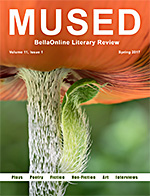Louisa May Alcott's "Little Women" as Muse
Linda Ann LoSchiavo
When I was four years old, my aunts began taking me to the theatre. Though I loved these experiences, I also felt a little sad. Why weren’t there meatier roles for stage actresses?
My father had introduced me to Italian opera when I was still in the crib, drawing my attention to his favorite sopranos and their importance to the story. If most opera plots pivoted around the soprano, then why didn’t Broadway musicals? There was an imbalance here.
At nine years old, in my local library, I discovered “Little Women” written by Louisa May Alcott [1832–1888] and identified with Jo March, a bookworm who composes plays for her sisters to perform. Except for my favorite librarian, however, there was no one to discuss it with. My classmates hadn’t heard of Alcott yet.
Alcott’s Chapter 2 [“A Merry Christmas”] pointed the way.
Louisa May Alcott wrote:
Being still too young to go often to the theater, and not rich enough to afford any great outlay for private performances, the girls put their wits to work, and necessity being the mother of invention, made whatever they needed. Very clever were some of their productions, pasteboard guitars, antique lamps made of old-fashioned butter boats covered with silver paper, gorgeous robes of old cotton, glittering with tin spangles from a pickle factory, and armor covered with the same useful diamond shaped bits left in sheets when the lids of preserve pots were cut out. . . . Presently a bell sounded, the curtains flew apart, and the operatic tragedy began.
If the little March sisters could “put their wits to work,” then so could I.
Selecting a few chapters with incidents that could stand alone as a beginning, middle, and ending, I created my first one act play, writing fresh dialogue for five of Louisa May Alcott’s female characters: Marmee and her four daughters.
Like most 9-year-olds, I had no money. Nor did I have sisters for collaborators.
Thanks to Alcott’s encouragement, none of this was a drawback. Auditions were held at my next Girl Scout Troop meeting. For costuming, fabric remnants became five simple aprons and five long skirts. And the set? Simply an old rocking chair. My theatre-going outings served me well. I knew to avoid extra fuss — — such as Jo March’s clever “pasteboard guitars, antique lamps” — — and to side-step “operatic tragedy” because young audiences enjoy light comedy and witty dialogue. My 45-minute one act ran for months, circulating among local Girl Scout Troops and introducing people to my favorite novel.
Louisa May Alcott wrote:
It was excellent drill for their memories, a harmless amusement, and employed many hours which otherwise would have been idle, lonely, or spent in less profitable society.
And typing my first script five times on my manual typewriter certainly improved my memory. When one actress was a last minute no-show, I was able to step right into the role.
With a successful production behind me, I looked at narrative differently, supplying my own dialogue as I imagined the story recreated as a radio drama or a stage play. I chose more novels written by women or fiction that featured fearless female protagonists like Alcott’s Jo March.
Currently, the stage plays I write are a mix between original creations and adaptations from novels and poems.
Thanks, Louisa May.

